Pinch me, I must be dreaming!
First of all, I must apologise for the very long delay in producing this show report and keeping up with RISC OS news in general. The reason for this has been a combination of the usual workload (with the period after this show normally being one of my busy ones) with some health issues thrown in for good measure, including a short but unexpected – and very unwelcome – stay in hospital.
The most recent significant event in the RISC OS Calendar took place on October 27th, at the St Giles Hotel in Feltham, near Heathrow – the London Show, 2012 – and with new RISC OS computers, the official launch of RISC OS for the Raspberry Pi, and a visit from Eben and Liz Upton from the Raspberry Pi Foundation, that day can be summed up in one simple word: Wow!

The show was a very busy – and buzzing – one. As an exhibitor, it felt to me that the attendance numbers were up (and it turned out they were); I was certainly kept busier on my stand than usual, and although I did wander around the show at times, I wasn’t able to do that as much as I have done in the past. And when I did get to wander, I found other exhibitors were busy (if they weren’t giving their/attending others’ theatre talks), so I didn’t speak to as many as I’d have liked. This will be reflected in this show report, with some sadly sparse commentary on some exhibitors – and, as ever, if I’ve missed anyone out completely or got something wrong, I apologise!
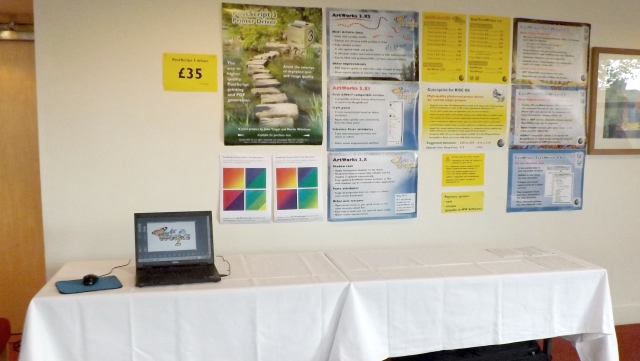
The first exhibitor a visitor might have encountered, if he wasn’t already too busy with other people, would have been Martin Wuerthner. Martin was one of those I didn’t speak to this time, but I gather from others that Martin’s big news didn’t include new versions of any of his software – it was a new version of himself, instead. Well, sort of; Martin has recently become a father, so congratulations on the birth of your daughter, Martin, and good luck with those sleepless nights!
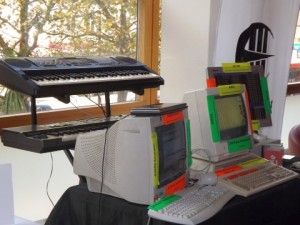
Directly across the hall was the ROUGOL stand, where the guys would have been trying to entice any local visitors into joining the group. Next, Trevor Johnson was again encouraging people to participate in WikiProject RISC OS, with the aim of improving the quality of RISC OS related material on Wikipedia. RPCEmu, a free solution for emulating Acorn Risc PC and A7000 hardware on a number of platforms, was on the adjacent stand, and following this was the 3rd Event Technologies stand, on which AMCS – their Advanced Music Construction System – could be seen running.
Next, The Centre for Computing History could be found with, amongst other things, a disk imaging system called Kryoflux. This was brought along so that the museum could make preservation quality disk images of old RISC OS software for their archive.
Across the hall, Peter Nowosad was impressing visitors with fast Mandelbrots created in Charm on the Raspberry Pi, benefiting from the instruction set of the built in VFP co-processor. Next to Peter, Organizer was being demonstrated.
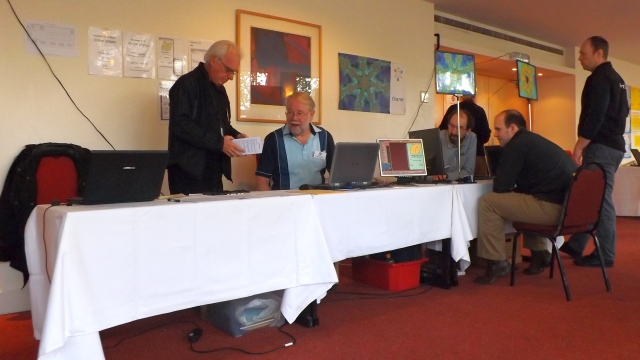
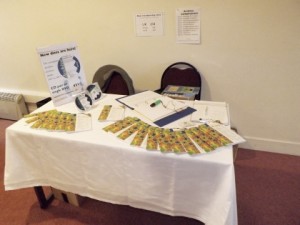
After the Organizer stand was a set of doors leading to the first of the side rooms that were being used for exhibitors (the side room before this one was being used for the show theatre), and the first exhibitor in this room was Archive Magazine. The latest issue – volume 23 issue 5 – was available for subscribers to collect, featuring articles on the Alpha version of RISC OS on the Raspberry Pi, write-ups of the main shows of 2012 so far, a guide to Charm, and much more. The magazine felt bigger than usual, but that turned out to be a printing issue: Jim explained that there had been a problem at the printers’, so in order to have a batch ready for the show, they were printed digitally on heavier paper than usual. The copies to be posted out to subscribers can be expected in due course, and will be lithoprinted as per normal on paper that won’t make them too heavy for the usual postal band. After long gaps between issues for a while now, Editor Jim Nagel hopes to get the magazine back to a regular publishing cycle from the next issue.
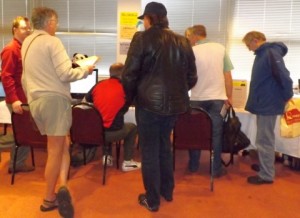
Also in this room was the R-Comp stand with a wide array of machines on display, including not only the ARMini, but also a new toy – the ARMiniX. This new machine is based around the PandaBoard (whereas the ARMini is based around a BeagleBoard), and sports a 1.2GHz ARM Cortex A9 processor, 1024MB (1GB) of high performance RAM, and a CD/DVD read/write drive.
R-Comp also launched a new support scheme to go alongside the BeagleBoard and PandaBoard schemes – this time for users of the Raspberry Pi. These schemes provide owners of the various ARM-based boards with a fully licenced copy of RISC OS, supplied on an SD card, documentation, accessories, and an expanding selection of free-to-download software.

PlingStore was another new offering from the company, and this is designed to be an easy way to locate and download applications. With an internet connection, the application will interrogate an online repository of software, and present it to the user neatly categorised. As the number of applications provided through PlingStore grows, it should make it easier for users – particularly those new to the RISC OS community – to find the software they want or need. Instead of loading a web browser, typing a suitable search term into Google and searching that way – which can be a frustrating way to search, especially if the actual name of the application isn’t known – they can just run PlingStore and navigate its interface to find the category of software they’re after and, assuming they find something, download it. And, of course, it’s possible to just browse what’s on offer, as well. The application isn’t currently available to download, but it does come supplied on the latest RISC OS disk image for the Raspberry Pi – but more on that later.
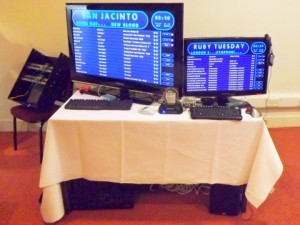
The third exhibitor in this room was Michael Emerton, with Mustick (formerly RiscDJ), a management and playback system for digital music, supporting hundreds of thousands of MP3 and OGG files. The change of name for this application apparently came about because of the early Raspberry Pi development boards that Michael had seen in the news, the shape of which was more like a USB stick – however (presumably because the final product is no longer that shape), he is now considering alternative names. The application isn’t currently available to download due to hosting problems, but at some point it is likely to appear in R-Comp’s PlingStore.
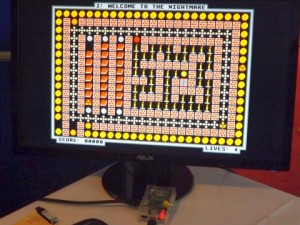
Back in the main hall, the next stand was mine – Soft Rock Software. This time, the only computer I’d brought along was a Raspberry Pi, and I was happily explaining to people that in the few days before the show, I’d found demo versions of some of my old budget games, which worked perfectly on the Pi. I’ve been looking for backup copies of the full games for some time, but haven’t yet found them – and Martin Bazley (thanks, Martin!) came to the rescue, bringing with him a memory stick containing full copies of three of them: Guardians of the Labyrinth, Escape from Exeria and Floopy, as found on an old Acorn User cover CD. With a quick tweak to disable the sound (which uses modules that aren’t 32-bit compatible) the first two of these were soon running on the newest and cheapest RISC OS computer ever – but Floopy was written in C, and the source code long since lost, so it wasn’t possible to get that one running.
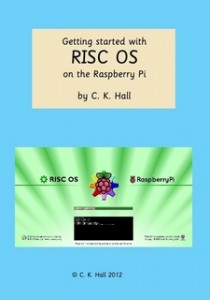
Visitors to the show were also – for the first time in many years – given the opportunity to hand me some cash, albeit not for something of mine! Fellow Bristol RISC OS User Chris Hall has written a short book called “Getting Started with RISC OS on the Raspberry Pi” which he’d brought along to the show, and asked if I could try selling some from my stand – which I did. For those interested in giving the book a read, but who weren’t at the show, it can of course be ordered online.
Adjacent to the Soft Rock Stand was the Sine Nomine, where Matthew Phillips was tempting visitors with Impact and its offspring, ImpEmail, along with a selection of puzzle games such as Wrangler and SuperDoku.
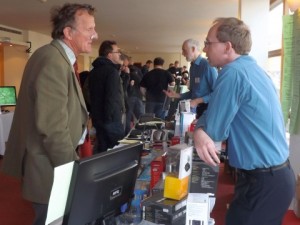
More or less opposite our two stands, CJE had once again forgotten to bring a kitchen sink – but had just about everything else, including three new offerings to contribute to this show being a memorable one: They were launching three new computers at the show, the Panda RO and the Raspberry RO (with RO in both cases pronounced as a single word, rather than as the two letters individually) and the Lapi. As you might guess, the first two computers are based around the PandaBoard and Raspberry Pi respectively. The third is also based around the Raspberry Pi, but this time configured as a laptop.
Crossing back over, a set of doors would lead the visitor into the third main room of the show: Room 3.14, where Raspberry Pi specific projects were on display.
The first exhibitor in this room was Steve Drain, who was demonstrating Basalt, his module that provides a comprehensive set of extensions to BBC BASIC on RISC OS. What’s so special about Basalt that warrants it being in Room 3.14? Surely not that it runs on the Raspberry Pi – because plenty of stuff at the show was running on one! No, it was because of what Steve has done with a Raspberry Pi, which was to attach it to a Atrix Lapdock case (designed for a Motorola mobile phone!) and thus run it – and RISC OS – as a laptop.
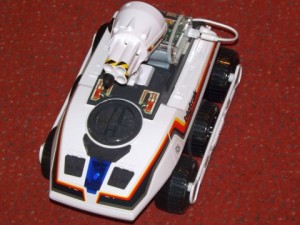
Also in this room, your ankles could be attacked by a radio control vehicle – a BigTrak – which was heavily armed with heat seeking little plastic missiles. Actually, your ankles could be attacked by it in the main hall as well, as mine were when ROUGOL’s Bryan Hogan was playing with it. There were actually two BigTraks, brought along by Leo White, and while one was armed, the other one had a robotic arm attached – as well as an ARM being attached in both cases due to there being one on the Raspberry Pi that was mounted on the backs of each of the two vehicles.
Returning to the main hall once again, immediately to one side of the doors the charity stand had a wide selection of goods on offer to kindle those nostalgic fires, and in doing so providing much needed to support to a worthy cause: Combat Stress, a charity specialising in the care, support and treatment of British Armed Forces Veterans suffering with mental health problems.
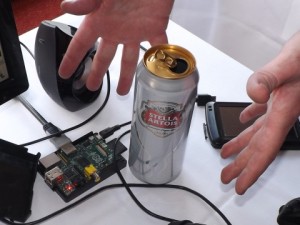
Across the way, Keith Dunlop of Usable Range had brought along a very small keyboard.
Oh, yeah, he also had both a PandaBoard and a Raspberry Pi, and he was merrily showing off RISC OS running on the fastest hardware ever to run the operating system directly (the PandaBoard) and the cheapest hardware ever to run it (the Raspberry Pi).
Next to Keith, Richard Brown of Orpheus Internet was talking to people about the various services they offer, and about the new control panel they will soon be providing to customers using their hosting packages – Blue Onyx.
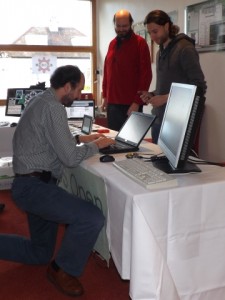
At the very end of the main hall, RISC OS Open Ltd were present with some very significant news: RISC OS Pi, the first official release of RISC OS for the Raspberry Pi, was now available to download from the Raspberry Pi website – and for just £10, SD cards could be purchased with the operating system and default disk image already installed and ready to use; just insert the card into the slot on the Pi, power it up, and it’ll boot into RISC OS (and very, very quickly as well). The cards themselves weren’t available at the show, but ROOL were taking orders (and giving customers a voucher as proof of purchase) with the cards to be shipped out later. (And many thanks to Steve Revill for writing the new image to my own SD card at the show, enabling me to demonstrate my software on the latest and greatest version!)
ROOL were also offering [vouchers for] Nut Pi, a wide selection of software gathered together and put on an SD card, for the very reasonable price of £35. Included on the card are DataPower, PhotoDesk, Impact, Messenger, Luafox and much more – all full versions, rather than feature limited or cut down versions, but tailored so that they will only run on the Raspberry Pi. The total combined retail value of the software is several hundred pounds – so anyone who buys the cheapest computer to ever run RISC OS can also get a very good selection of software for the operating system at a similarly cheap price.
I’m told that Eben and Liz Upton spent much of their time at the show at the RISC OS Open stand – though I didn’t actually see them there myself. I didn’t even realise I’d photographed Eben speaking to Peter Nowosad about Charm until today when I was sorting through the photos for this report!
And speaking of photographs, here are a few more:
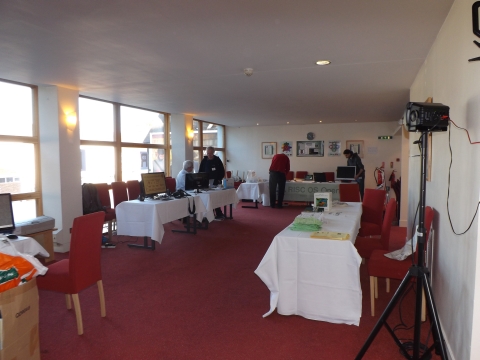
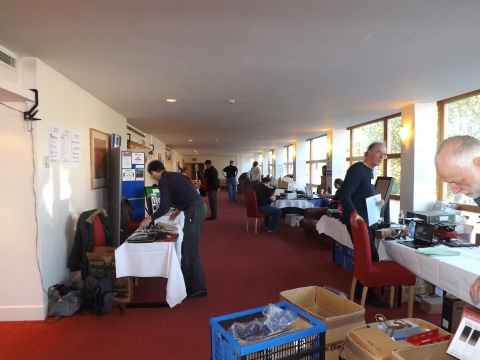
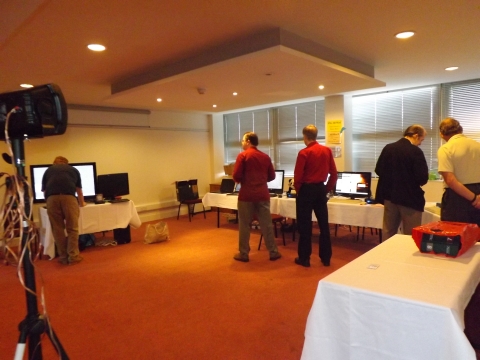
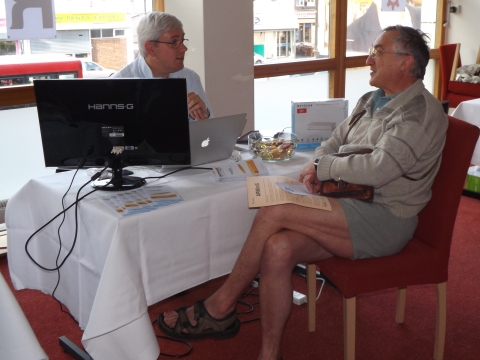
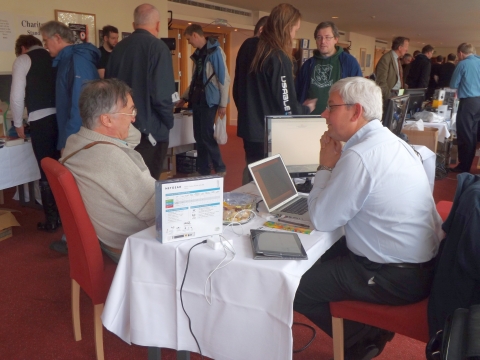
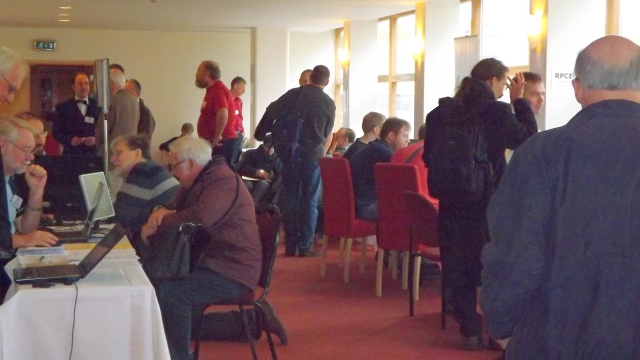
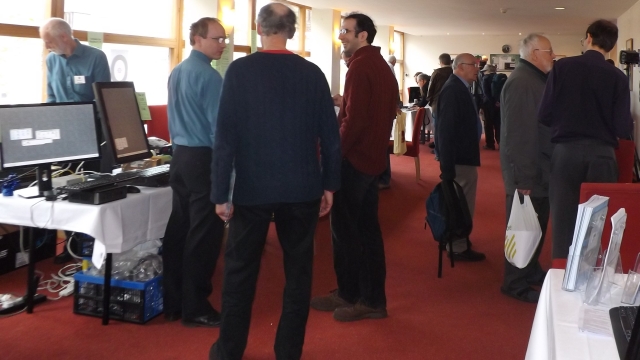
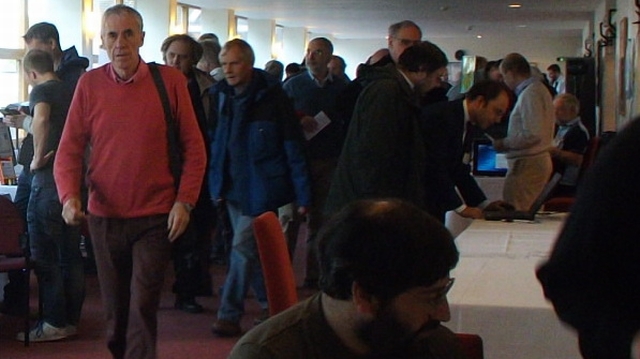
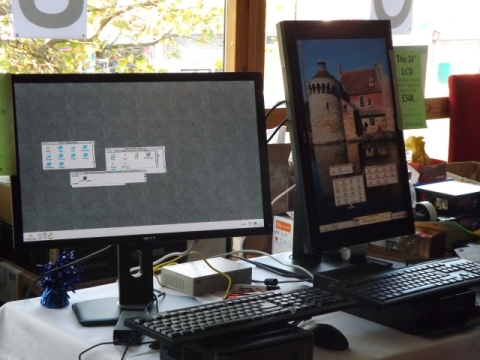
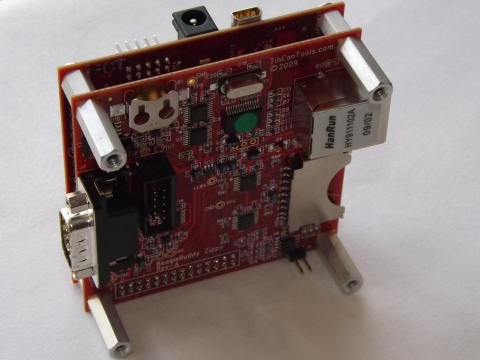
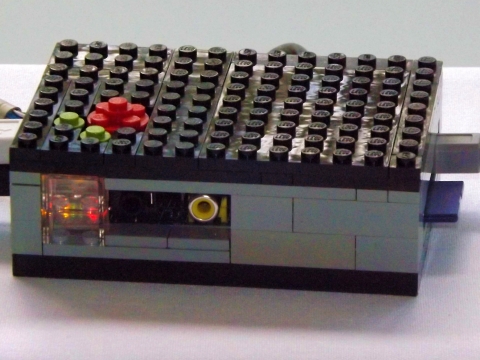




It’s “Emerton” with one M.
Now fixed – cheers.
Ironically, some time after I hit publish, I noticed that I’d spelt it with one ‘m’ in one place, and two in another. So I fixed it. The wrong way around. 🙂
[…] What a show – London 2012 […]
[…] […]
[…] with a new editor and publisher in the form of Christopher Dewhurst – and, shortly after the London Show, Chris announced that volume 4, issue 1 of the magazine was available to buy, with a sampler of the […]
[…] around the time of the 2012 London Show, Dave Stratford released an update to his website/gallery generator, WebGen2, bringing it up to […]
[…] day before the recent London Show, Steve Fryatt, who was unable to exhibit at the show, announced updates to two pieces of software […]